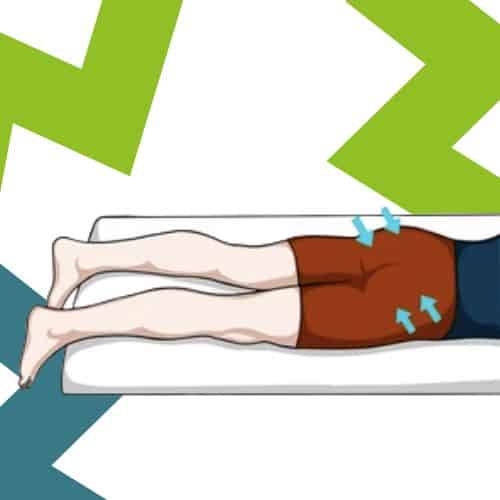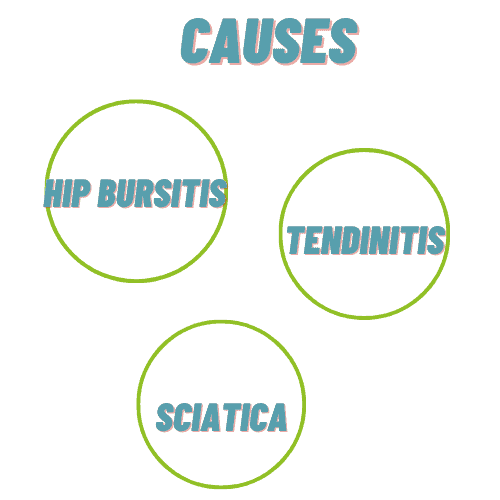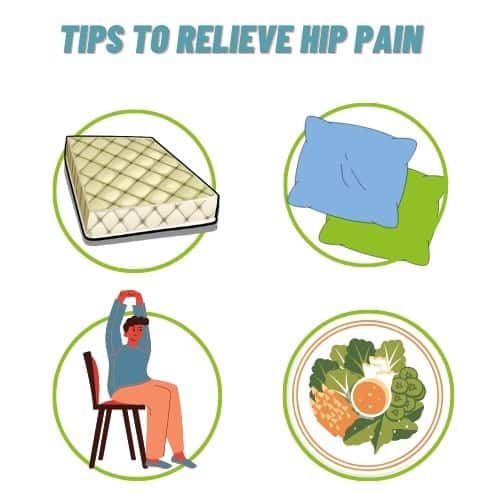Chronic pain makes it hard for most people to get a good night’s sleep. This is because every time you move, your pain gets worse. For example, if you suffer from hip discomfort, it may be difficult to find a comfortable posture to sleep in due to the stress and strain on your hip joints.

When you are unable to sleep effectively, your capacity to heal and recover completely after an injury or from a painful health condition may be compromised. So, it is better to find strategies to relieve hip pain while sleeping.
Continue reading to learn more about hip pain while sleeping, as well as its causes and potential treatments.
What Causes Hip Pain While Sleeping?
We all know that attempting to find a comfortable resting posture at night may exacerbate or aggravate hip pain. So, before discussing effective methods to alleviate hip pain while sleeping, let’s examine the injuries and health issues that can cause hip discomfort while sleeping.

1. Hip Bursitis
Our joints are supported by fluid-filled sacs present in every joint. When one of these fluid-filled sacs in your hip joint becomes inflamed, you may be identified with hip bursitis. This disorder is typically brought on by repetitive motions that place pressure and stress on the joints, resulting in inflammation. Additionally, if you have hip bursitis, your hip may feel stiff and sore and certain activities may be painful. Hip bursitis can also cause sharp, shooting pains, as well as localized edema and redness.
2. Tendinitis
Tendinitis is an inflammation of the connective tissues between bone and muscle. If a tendon in your hip becomes inflamed, you may experience discomfort and pain with even the slightest motions. Tendon irritation and inflammation can cause localized muscle tightness, soreness, discomfort, and weakening. Moreover, Tendinitis is prevalent among athletes who engage in repetitive hip and leg motions, such as cycling, swimming, and running.
3. Sciatica
The sciatic nerve is positioned at the base of the spine and runs through the buttocks, thighs, and hips. When the sciatic nerve is irritated or injured, it can produce sciatica, which is characterized by discomfort and pain in the lower back and lower part of the body.
Sciatica can be caused by spinal stenosis or herniated disc in the lower back. If you have sciatica, you may see that certain motions or positions can exacerbate the pain and suffering. Most frequently in one leg, sciatica symptoms include numbness, weakness, and tingling.
Tips to relieve hip pain while sleeping

1. Investing in a great mattress
Investing in a great mattress is perhaps the most expensive way to prevent hip pain during the night. Until we upgrade, the vast majority of us are unaware of how significantly our mattresses affect our lives.
If you feel hip pain when sleeping on your side, a mattress that is overly firm is one of the most important features to avoid.
Although spring mattresses are typically an inexpensive alternative, they have little “give” and do not adjust to your body adequately. When sleeping on the side of a spring mattress, more pressure is exerted on the hips and shoulders when sleeping on the side.
Support, firmness that suits your body and sleeping style, and the ability to mold to your body’s curves are the most important characteristics of a high-quality mattress. The goal is to keep your spine in a straight line, whether you sleep on your back, stomach, or side.
Numerous individuals who experience hip pain when sleeping on their side should pick medium-firm mattresses that border on the plush side. These provide enough give to gently cradle your shoulder and hip, without allowing you to sink fully into the mattress and cause your back to be out of alignment all night long.
However, selecting a comfortable mattress can be difficult if you share a bed with your significant other. Particularly if you and your partner have distinct sleep habits and needs. There are, however, beds that handle the issue of diverse mattress preferences, such as the sleep number mattress. This type of bed allows each individual to adjust the desired level of firmness for the best comfort.
2. Use Cushions to Your Advantage
The location of a pillow can play a vital role in relieving discomfort associated with sore, tender hips. A wedge-shaped pillow can be positioned beneath the lower back or below the knees for back sleepers. This aids in slightly elevating the hips and relieving strain on them. A pillow can be placed under or between the knees of side sleepers. Again, the objective is to ensure that the sensitive hip is not driven into the mattress and is not under excessive strain. If you do not have a pillow of the appropriate size, a folded blanket or towel may suffice.
3. Stretch Prior to Bedtime
Light stretching before bedtime is an additional method for alleviating hip pain. Consider, for instance, a hip flexor stretches: Place your hands on your hips and move your pelvis and body forward until you feel the muscles in your hips stretching down.
The butterfly stretch is another beneficial stretch. Sit on the floor with your knees bent and your feet pressed together. Bring your heels as close to your body as possible, and use your elbows to press down on your knees. These few stretches may help alleviate some of the tightness and tension in your hips, allowing you to rest more comfortably before bedtime.
4. Get Good Exercise
Daily physical activity is recommended, but for those who live with hip pain, it’s important to choose your exercise carefully. High-impact activities, which can include, jumping running, or even hiking on uneven terrain, put a lot of strain on your joints, and can inflame hip pain. Low-impact, less strenuous exercises may be better. Try some basic stretching, like yoga; taking a moderately-paced walk; or swimming.
5. Maintain A Healthy Diet
Nutrition is another key component in reducing hip pain. For starters, eating a sound diet can help you lose weight, which leads to less pressure on your joints throughout the day. Nuts, seeds, colorful fruits, root vegetables, and whole grains all include nutrients that strengthen the joints. There are also certain foods that can help prepare your mind and body for sleep, such as fatty fish, nuts, rice, and perhaps even a small glass of milk.
References
- Lespasio, M. J. (2022). Lateral Hip Pain: Relation to Greater Trochanteric Pain Syndrome. The Permanente Journal, 26(2), 83-88.
- Campbell, A., Thompson, K., Pham, H., Pickell, M., Begly, J., Wolfson, T., & Youm, T. (2021). The incidence and pattern of iliopsoas tendinitis following hip arthroscopy. HIP International, 31(4), 542-547.
Related Articles:
- How to Burn Fat While Sleeping
- How to Lose Weight While Sleeping
- How to Stop Snoring While Sleeping
- How to Prevent Dry Mouth While Sleeping
- What Causes Leg Cramps While Sleeping
- How to Decompress Spine While Sleeping
- How to Clear a Stuffy Nose While Sleeping
- How to Increase Oxygen Levels While Sleeping
- How to Relieve Lower Back Pain While Sleeping
- How Many Calories Do You Burn While Sleeping
- What Should Your Heart Rate be While Sleeping
- What Causes Headaches at Night While Sleeping
- What Causes Extremely Dry Mouth While Sleeping
- How to Improve Circulation in Legs While Sleeping
- How to Relieve Back Pain During Pregnancy While Sleeping
